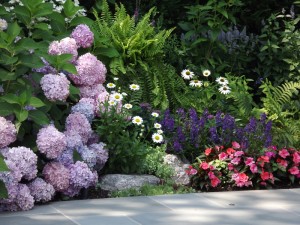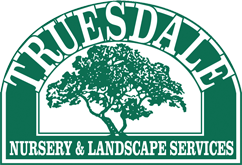13 May Maintaining Perennials
 Year In And Year Out, These Special Plants Provide An Abundance Of Joy
Year In And Year Out, These Special Plants Provide An Abundance Of Joy
While most seasoned gardeners and nurseries alike will recommend a mix of annuals and perennials in your garden, the task can seem quite daunting.
As for the perennials (plants that grow back every year), questions abound. Where to start? What plants to select? How to plant?
But not to worry. With a few simple techniques, you’ll be able to sit back and watch your perennials flourish.
“Perennials are a true joy for any gardener,” said Ralph Dinizo, President of Truesdale Nursery & Landscape Services of Berkeley Heights, N.J., one of the state’s premiere landscaping and nursery specialists. “To see the fruits of your labor literally come to life each spring is something very special.”
Start by assessing the status of your garden. Do you have lots of spreading plants that seem invasive? Do you have plants that are bushy and seem to be growing out of control? Are some plants that used to grow well growing poorly now? Does it seem that weeds are taking over? Are there plants you would like to replace? Look at the individual plants as well as the overall garden.
An easy factor to fix is the need for fertilizer. Most plants benefit from regular feedings during the growing season. Use a good balanced fertilizer in one of several forms. Controlled release pellets (called prills) and the water-soluble types that are either mixed with water and sprinkled on or are used in a special dispenser attached to a watering hose are most popular. A good balanced fertilizer often does wonders to increase growth and enhance flowering. Remember compost is also a source of nutrients.
A fertilizer high in nitrogen (the first number) will increase the growth of foliage, while a fertilizer high in phosphorous (the middle number) is good for root growth and flowering and is important in cell division. Using a fertilizer high in phosphorous but lower in nitrogen will help flowering species reach their full potential without focusing too much on leaf growth. Most perennials end up spindly and unattractive when high-nitrogen fertilizers are applied.
Assess which plants need to be pruned. Some plants need pruning to control spreading and guide new shoot growth. Some plants need pruning to refresh and increase new growth or to remove old or damaged parts. Either way, the process is the same. Decide which shoots need to be cut, and figure out how far back the plant should be pruned. This can be purely aesthetic, based on your preference, or it can be based on where the damage occurs on the plant. Find the closest branching point (called a node) just below the area of damage or overgrowth, and make a 45-degree cut just above the branching point. Don’t cut too near the node, or the cut may not heal; about ¼ inch above the joint is fine. If there is no branch, find a leaf with an intact axillary bud (the little bud between the top of the leaf and the stem of the plant) and make the cut just above the leaf. The bud will “break” and form another branch there. For smaller plants or herbaceous (not woody) growth, a cut may not be necessary. Many times, pinching off the extra branch is enough.
Another aspect of perennial care is weeding. Much of work that should be done when installing the bed is removing perennial weeds, using a weed mat and mulching well. However, even a well-planned garden can fall prey to pesky weeds. Hand weeding the garden is most effective. It’s vital to pull weeds before they mature so that they don’t take needed nutrients from the perennials and leave seeds in the garden. Perennials have enough work growing without competing with weeds for food, water and space. Weed seeds can lay dormant in soil for long periods before germinating. Take care not to leave any sections of the weeds in the soil, for they will often grow back from small pieces of root or other plant material.
After the weeding is done, consider the need for additional mulch. Mulch upkeep is one of the best maintenance practices available to keep a perennial garden healthy. Recommended mulches include many organic materials, from pine straw to shredded pine bark and compost. A layer of mulch 2 to 4 inches deep is recommended for most plants. The actual depth will depend on cost, personal preference and availability.
Why do plants need mulch? There are several reasons — weed control and reducing the need for watering, and temperature control for root protection. By covering the soil, mulch prevents the water in the soil from evaporating as quickly. By maintaining the moisture level in soil and providing insulation from hot and cold weather, mulch can help prevent extremes in air temperature from affecting the roots. Mulch also can protect the leaves of plants from soil washing or bouncing onto them. Another function of mulch is purely decorative. The garden simply looks better when the mulch is in place, framing the plants and providing an even, dark attractive background. Maintaining mulch is one of the best and easiest ways to help your garden grow.
For plants spreading out of control, consider giving them more room by dividing them. This requires separating the plants by digging them up and pulling apart the plants and roots. This leaves you with intact plants ready to put back into the soil. You can divide most perennials every 3 to 5 years if desired, or you can leave them a little longer if they have room to thrive without crowding another species. Some plants may benefit from thinning, especially those that are overcrowded or prone to rot in the rain. Some silver-foliaged species are especially prone to rot. Wet, thick foliage tightly packed together will increase the tendency for disease problems.
Flowering is another area where your perennials might need help. Many species will re-bloom if the old flowers are pulled off. This process is known as “deadheading.” It allows the plant to re-bloom by preventing the flower from setting seed, which is the plant’s goal for the season. It’s important to deadhead flowers as soon as they fade. Some gardeners find this a rewarding way to spend time in the garden every afternoon. An added benefit of deadheading is the improved appearance of the plant. Removing the spent blossoms rejuvenates the garden’s fresh look.
Fortunately, perennials are forgiving, and the plants seem to always bounce back. Don’t worry about “getting it perfect” as you work on your technique. Try your hand at some of these methods and see how well your garden grows!
Where Do I Get Help If I Need It?
There are a multitude of resources on the Internet. And of course your local lawn care professional is just a phone call away. Truesdale is here to help. Contact us today.


